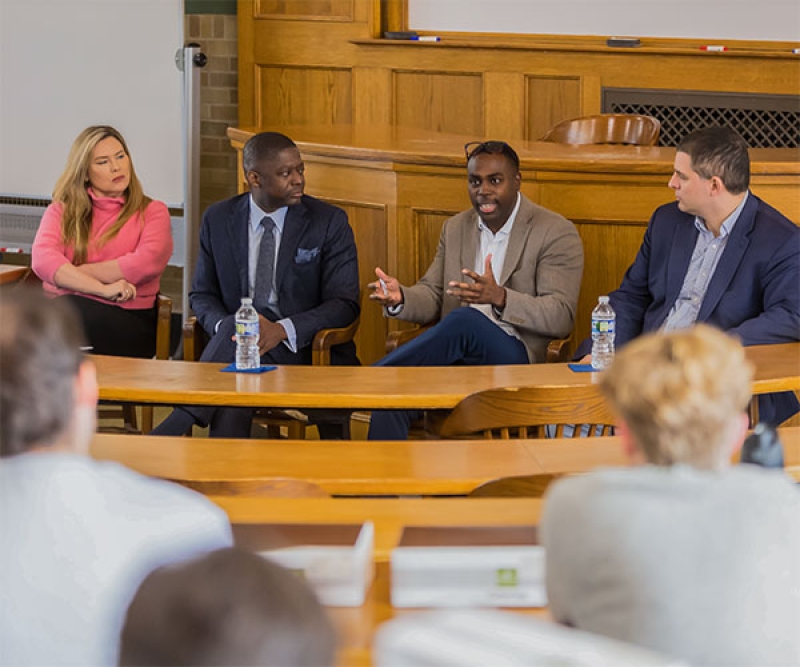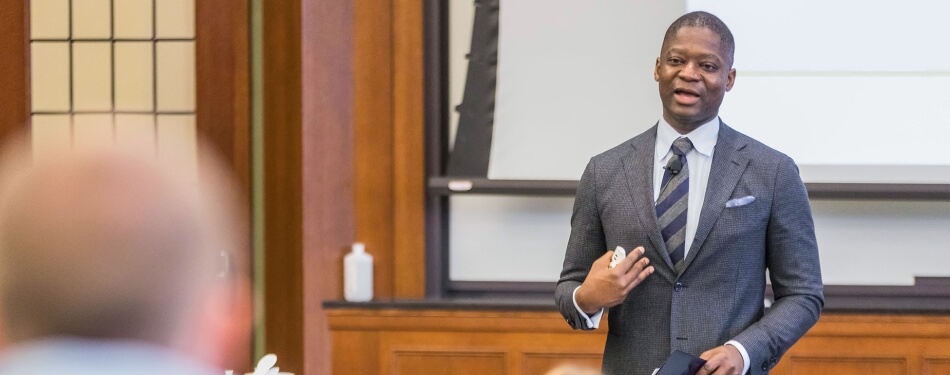As the country reckons with the death of Tyre Nichols, yet another unarmed Black man killed by excessive police force, Michigan Law Professor Ekow Yankah led discussions with the Law School community and his class in criminal justice on the history and social impacts of racialized policing. Below are four key takeaways.
1. Police seizures in America are deeply racialized, which has its roots in slavery.
Policing of Blacks in the United States began with slave patrols—groups that captured runaway slaves, often by use of excessive force. Within the same general time frame, modern policing was developing with the introduction of Robert Peel’s rules of policing in 1829.

“Policing in America was unquestionably preoccupied, in particular in the South, with the control of runaway slaves,” said Yankah, the Thomas M. Cooley Professor of Law. While the 13th amendment outlawed slave patrols, that mindset became embedded in policing in the US, including the North, where police focused on domination of African Americans along with immigrants, the underclass—and the poor.
Problems of poverty, and in particular problems of racialized poverty, are treated as policing problems, not as social problems, said Yankah.
He cited the case of Eric Garner, who died in 2014, among the many, many cases of Black men who have died at the hands of police for minor crimes. New York City police officer Daniel Pantaleo placed Garner in a prohibited chokehold for selling loose cigarettes without a tax stamp. Garner died after stating several times, “I can’t breathe.” A grand jury did not indict the officer.
2. Diversifying the police force by itself isn’t the solution to racialized policing. Changes to the structure of policing are needed.
The five officers initially arrested after Nichols’ death were all Black, which, Yankah noted, is not uncommon. When Black parents have “the talk” with their children about how to interact with police and other authority figures, the race of police doesn’t factor into the conversation.
“Let me assure you, I do not know Black fathers who say, ‘Oh, if it’s a Black police officer, you’re not in danger,’” Yankah said. “That’s not how the conversation goes.”
The reason is that racialized policing is due to the structure of policing—with its roots in those early slave patrols. Additionally, police are trained to treat everyone as a threat.
“It’s wildly overstated in training,” said Yankah. “This is a deeply corrosive way of relating to the people you’re supposed to protect.”
3. Deadly force should not overshadow the damage to survivors of excessive police force.
When police were arresting Tyre Nichols, they might not have been intending to use deadly force, only to rough him up and scare him. If he had survived, his case might not have gotten the attention it has—just like many of the victims of police seizures who are beaten, kicked, and otherwise humiliated.
“We tend to let those cases disappear even though they can be destructive and undermine the legitimacy and trust in police,” said Yankah. He likened the situation to casualties of war. Statistics account for those who die, while those who are injured but survive sustain lifelong impacts.
4. A police officer may not use deadly force to prevent escape.
The case of Tennessee v. Garner involved Memphis police officers who, in 1985, chased 15-year-old Edward Garner (no relation to Eric Garner) as he fled a house where he had just stolen a wallet containing $10. As Garner scaled a fence, the police shot him in the head and killed him.
At the time, a Tennessee statute allowed police to shoot a fleeing felon, so the police claimed the law was on their side.
The US Supreme Court held the statute unconstitutional, stating that a police officer may not use deadly force to prevent a fleeing felon unless the officer has probable cause to believe the suspect poses a threat of serious physical harm either to the officer or others.
“Tennessee v. Garner stands for the proposition that even if an arrest is based on probable cause, the method of arrest must be reasonable,” said Yankah.
While the case didn’t get much media attention when it was decided, added Yankah, “it is one of our lodestars of constitutional law.”
He added that, in Graham v. Connor, the Court held in 1989 that analysis of whether an officer has used excessive force is subject to the Fourth Amendment’s “objective reasonableness” standard rather than a substantive due process standard.
“We’re going to look at the severity of the crime at issue, we’re going to look at whether or not the suspect poses a threat, and we’re going to look at whether or not they’re actively evading arrest,” said Yankah. “But the Court has told us, in this particular field, we cannot reduce it to a formula.”
When it comes to what constitutes proportionate force, the jury is out, so to speak.
In Scott v. Harris, the Court decided in 2007 that an officer did not violate the Fourth Amendment by ramming a vehicle during a high-speed chase, which left the fleeing driver paralyzed. The Court allowed as evidence a video of the chase, which is highly unusual.
Three law professors used the video in a study published in the Harvard Law Review that showed a majority of respondents agreed with the Court’s decision. However, the numbers of both women and racial minorities were dramatically lower in agreeing that deadly force was required.
Cases like Scott v. Harris remind us, Yankah said, “that there’s going to have to be a judgment call about what constitutes disproportionate force and, not surprisingly, given our racial experiences, different people are going to have different views.”







